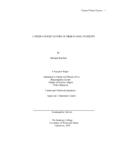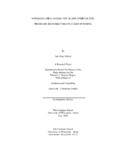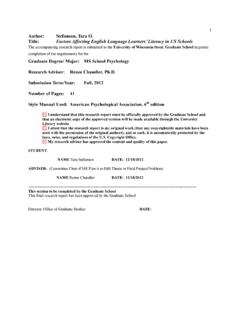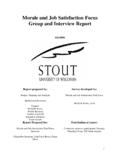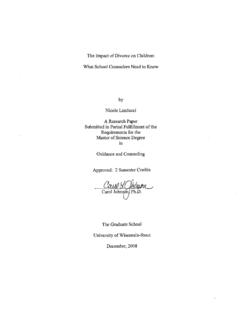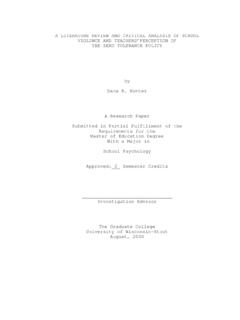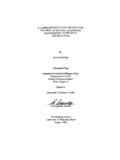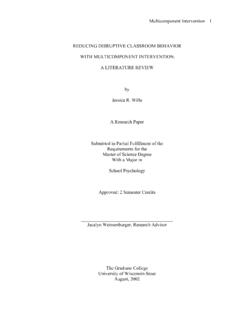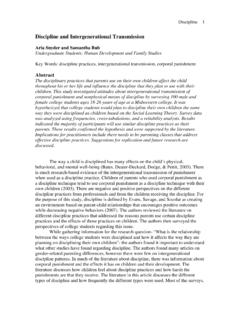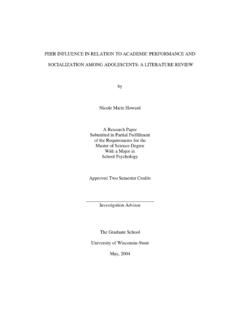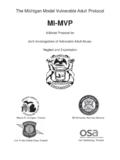Transcription of Child Abuse and Neglect: by Kyrsha M. Dryden A ... - UW-Stout
1 Child Abuse and neglect : A Resource Guide by Kyrsha M. Dryden A Research Paper Submitted in Partial Fulfillment of the Requirements for the Master of Science Degree III. Education The Graduate School University of Wisconsin-Stout December, 2009. The Graduate School University of Wisconsin-Stout Menomonie, WI. Author: Dryden , Kyrsha M. Title: Child Abuse and neglect : A Resource Guide Graduate Degree/ Major: MS Education Research Adviser: Amy Schlieve, MonthrYear: December, 2009. Number of Pages: 27. Style Manual Used: American Psychological Association, 5th edition ABSTRACT. This resource guide examines the research available surrounding Child Abuse and neglect . I will define exactly what Child Abuse and neglect is in a broad sense as well as specific types of Abuse and neglect .
2 The research identifies what population of children is most likely to be effected by Abuse and neglect as well as what adults will likely be abusers when they become parents. Although risk factors can be and are identified the prevalence of this epidemic is widespread and is not localized to one population or another. It is found in every population and every society around the world. That being said, basic risk factors have been identified and although there is no hard and fast rule there are basic guidelines that help educators seek help for these children. There are many strategies that educators can implement to attempt to improve the quality oflife of the Child and ultimately the entire family. This is an issue that is paralyzing our youth and their families.
3 It is one that is present in every classroom across the United States as well as the world. The Graduate School University of Wisconsin Stout Menomonie, WI. Acknowledgements I would like to first and foremost thank Dr. Amy Schlieve for her never ending support and guidance throughout the past several years. I began my graduate work in September of 2005, since then my life has gone through tremendous changes both positive and negative. Amy you have pushed me through this incredibly long process, without your support I could not have accomplished this. I thank you from the bottom of my heart, I. wish I could write how much this your support has meant to me. I need to thank my mother, Kathi, and my father, Robert, for their continued support. No matter what the obstacle has been they are always first in line to help me through.
4 There is no way that I could have survived the last five years without them in my life and only a phone call away. Finally, I need to thank my children, Zack and Rose. Zack was born when I started my undergraduate program and Rose came along when I started my graduate work. They are still here and holding strong with me. I dedicate this accomplishment to Zack and Rose as well as my grandparents, Dale and Evelyn. I love you all. TABLE OF CONTENTS.. Page ABSTRACT .. ii Chapter I: Introduction .. 1. Statement of the Problem .. 1. Purpose of the Study .. 2. Assumptions of the Study .. 4. Definition of Terms .. ~ .. 4. Limitations of Study .. 5. Methodology .. 5. Chapter II: Literature Review .. 7. Risk Factors and Prevalence .. 7. Education and Prevention .. 11.
5 Educational Implications .. 15. Chapter III: Discussion .. 19. Goal/objective .. 19. References .. 21. 1. Chapter I: Introduction Alekseeva (2007) stated, "Children make up the segment of society that is the most defenseless, vulnerable , and completely dependent on adults . It is the fault of adults when children end up in areas of natural disasters and catastrophes or zones of military combat operation and become the hostages and victims of physical, sexual, and emotional violence." In education today, as in years past and surely in years to come, Child Abuse and neglect is and will be an overwhelming epidemic. Teachers are faced daily with the prospect of having to call human services to report an incident of Child Abuse and/or neglect . Study after study has been conducted and an overwhelming amount of them find that Child Abuse and neglect is a behavior that is handed down from generation to generation and only with education can the behavior be broken.
6 As I began researching for this guide I decided that I should understand the numbers that are associated with Abuse and neglect . I found that girls are at a greater risk of sexual Abuse as compared to boys. The research has shown that 20-25% of women and 5-15% of men were sexually abused as children. An estimated 906,000 children are victims of Abuse and neglect every year. The rate of victimization is children per 1,000 children as found by the Prevention and Treatment of Child Abuse Organization. They also have found that 1,500. children die each year from Child Abuse which translates into four deaths per day. Of the 1,500. children that die each year, 79% ofthese children are less than four years old. Statement of the Problem Child Abuse and neglect is a problem plaguing children today.
7 I will be identifying the risk factors, prevalence and the interventions and/or parent education programs that are available. It is my intent to answer the questions of why Child Abuse / neglect happens, who it happens to and 2. finally what avenues to parents and educators have to improve the environment for the student or Child involved. Purpose of the Study The purpose of this research is to develop a resource guide for educators, caregivers, and parents so that they are able to understand Child Abuse and neglect . It is my hope that with increased understanding and knowledge educators, caregivers, and parents will be able to better protect and care for children in abusive and neglectful environments. I will be reviewing the current research that is available regarding Child Abuse and neglect .
8 At completion, this resource guide will provide educators, parents, and caregivers a checldist of sorts to guide them through recognizing the risk factors, understanding the prevalence, and finally identifying steps to be taken once a student is assumed to be in a situation of Abuse and/or neglect . I have been working in the field of special education for almost seven years. I have worked with children from ages 5-21. I also have four children of my own ages ranging from 5- 11. I am around children from most walks of life at almost every moment of the day. On nearly a daily basis I am faced with a situation that involves a Child in a situation of Abuse or neglect . In each case I feel that I would be better equipped to make the correct or best decision if I had a basic understanding of Child Abuse and neglect and its causes, risk factors, and prevalence.
9 Risk factors are clear and consistent throughout research. McDaniel and Dillenburger (2007) state that, "Children who are brought up by very young parents with no partner or family support or by a parent who has learning difficulties are seen to be at increased risk of neglect " (p. 102). The risk of a Child being abused and/or neglected rises if there is poverty, social isolation, 3. unemployment, housing problems, or lack of parental basic childcare skills. The trend is clear children who have young, poor and or uneducated parents are at high risk of being neglected or abused. Because of the close interactions I have with children and their families I have found trends and commonalities in the families that are being affected by Abuse and neglect . In most cases the Abuse and neglect has been happening in the family for generations.
10 Because I have worked in primarily rural communities I have had the opportunity to have interactions with multiple generations within a family that have attended the district. This has given me an opportunity to learn about the family histories and patterns for the children that I work with. Craig and Prang (2007) found the following: The intergenerational transmission theory postulates that being a victim of physical Abuse , or witnessing the Abuse of other family members, teaches boys to become violent. With continued exposure to violence, learning occurs through both observational learning and positive reinforcement in the form of approval for violent behavior. (p. 296). This theory shows a trend that children that are in abusive homes are more likely to be abused themselves.
